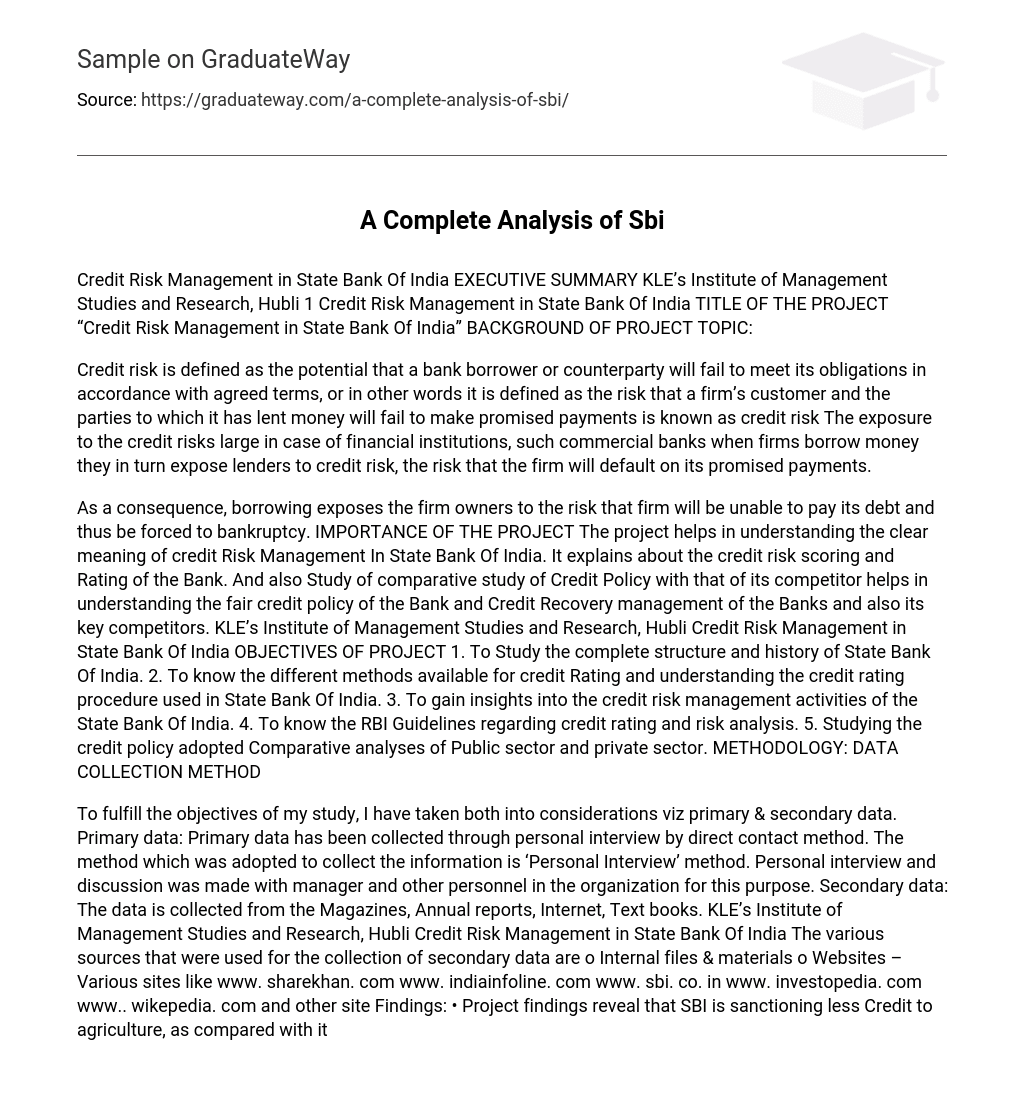EXECUTIVE SUMMARY
Institute of Management Studies and Research, Hubli 1 Credit Risk Management in State Bank Of India
TITLE OF THE PROJECT
“Credit Risk Management in State Bank Of India”
BACKGROUND OF PROJECT TOPIC
Credit risk is defined as the potential that a bank borrower or counterparty will fail to meet its obligations in accordance with agreed terms, or in other words it is defined as the risk that a firm’s customer and the parties to which it has lent money will fail to make promised payments is known as credit risk.
The exposure to the credit risks large in case of financial institutions, such commercial banks when firms borrow money they in turn expose lenders to credit risk, the risk that the firm will default on its promised payments. As a consequence, borrowing exposes the firm owners to the risk that firm will be unable to pay its debt and thus be forced to bankruptcy.
IMPORTANCE OF THE PROJECT
The project helps in understanding the clear meaning of credit Risk Management In State Bank Of India. It explains about the credit risk scoring and Rating of the Bank. And also Study of comparative study of Credit Policy with that of its competitor helps in understanding the fair credit policy of the Bank and Credit Recovery management of the Banks and also its key competitors. KLE’s Institute of Management Studies and Research, Hubli Credit Risk Management in State Bank Of India.
OBJECTIVES OF PROJECT
- To Study the complete structure and history of State Bank Of India.
- To know the different methods available for credit Rating and understanding the credit rating procedure used in State Bank Of India.
- To gain insights into the credit risk management activities of the State Bank Of India.
- To know the RBI Guidelines regarding credit rating and risk analysis.
- Studying the credit policy adopted Comparative analyses of Public sector and private sector.
METHODOLOGY: DATA COLLECTION METHOD
To fulfill the objectives of my study, I have taken both into considerations viz primary & secondary data. Primary data: Primary data has been collected through personal interview by direct contact method. The method which was adopted to collect the information is ‘Personal Interview’ method. Personal interview and discussion was made with manager and other personnel in the organization for this purpose.
Secondary data: The data is collected from the Magazines, Annual reports, Internet, Text books. KLE’s Institute of Management Studies and Research, Hubli Credit Risk Management in State Bank Of India The various sources that were used for the collection of secondary data are o Internal files & materials o Websites.
Findings:
- Project findings reveal that SBI is sanctioning less Credit to agriculture, as compared with its key competitor’s viz. , Canara Bank, Corporation Bank, Syndicate Bank
- Recovery of Credit: SBI recovery of Credit during the year 2006 is 62. % Compared to other Banks SBI ‘s recovery policy is very good, hence this reduces NPA
- Total Advances: As compared total advances of SBI is increased year by year.
- State Bank Of India is granting credit in all sectors in an Equated Monthly Installments so that any body can borrow money easily
- Project findings reveal that State Bank Of India sanctioning more loans as compared to other Banks. is lending more credit or
- State bank Of India is expanding its Credit in the following focus.
KLE’s Institute of Management Studies and Research, Hubli 4 Credit Risk Management in State Bank Of India. In case of indirect agriculture advances, SBI is granting 3. 1% of Net Banks Credit, which is less as compared to Canara Bank, Syndicate Bank and Corporation Bank. SBI has to entertain indirect sectors of agriculture so that it can have more number of borrowers for the Bank. SBI’s direct agriculture advances as compared to other banks is 10. 5% of the Net Bank’s Credit, which shows that Bank has not lent enough credit to direct agriculture sector. Credit risk management process of SBI used is very effective as compared with other banks.
RECOMMENDATIONS
The Bank should keep on revising its Credit Policy which will help Bank’s effort to correct the course of the policies. The Chairman and Managing Director/Executive Director should make modifications to the procedural guidelines required for implementation of the Credit Policy as they may become necessary from time to time on account of organizational needs. Banks has to grant the loans for the establishment of business at a moderate rate of interest.
Because of this, the people can repay the loan amount to bank regularly and promptly. Bank should not issue entire amount of loan to agriculture sector at a time, it should release the loan in installments. If the climatic conditions are good then they have to release remaining amount. SBI has to reduce the Interest Rate. SBI has to entertain indirect sectors of agriculture so that it can have more number of borrowers for the Bank.
CONCLUSION
The project undertaken has helped a lot in gaining knowledge of the “Credit Policy and Credit Risk Management” in Nationalized Bank with special reference to State Bank Of India. Credit Policy and Credit Risk Policy of the Bank has become very vital in the smooth operation of the banking activities. Credit Policy of the Bank provides the framework to determine (a) whether or not to extend credit to a customer and (b) how much credit to extend.
The Project work has certainly enriched the knowledge about the effective management of “Credit Policy” and “Credit Risk Management” in banking sector. “Credit Policy” and “Credit Risk Management” is a vast subject and it is very difficult to cover all the aspects within a short period. However, every effort has been made to cover most of the important aspects, which have a direct bearing on improving the financial performance of Banking Industry.





